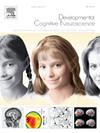Lifespan trajectories of motor control and neural oscillations: A systematic review of magnetoencephalography insights
IF 4.9
2区 医学
Q1 NEUROSCIENCES
引用次数: 0
Abstract
Motor control (MC) evolves across the human lifespan, improving during childhood and adolescence, stabilizing in early adulthood, and declining in older age. These developmental and degenerative patterns are linked to neural oscillatory activity, which can be assessed via magnetoencephalography (MEG) to gain insights into motor planning, execution, termination, and command initiation. This review systematically examined age-related changes in MC and neural oscillations, centering on movement-related beta desynchronization (MRBD), post-movement beta rebound (PMBR), and movement-related gamma synchrony (MRGS). Following PRISMA guidelines, 17 cross-sectional studies were identified. The findings revealed significant enhancements in motor efficiency from childhood to adolescence, characterized by faster movement speed, shorter movement duration, weaker MRBD, and increased PMBR and MRGS. From adolescence to early adulthood, further improvements in motor performance were noted, accompanied by strengthened MRBD, PMBR, and a slight decline in MRGS. In older adults, motor performance deteriorates, presenting as slower movement and prolonged duration, alongside heightened resting beta power, elevated MRBD, and reduced PMBR. Alterations in MRGS remain insufficiently explored. Overall, MEG proves valuable for capturing neural dynamics underlying the development and decline of motor control across the lifespan. These findings underscore potential avenues for motor rehabilitation and cognitive interventions, particularly in aging populations.
运动控制和神经振荡的生命轨迹:脑磁图的系统回顾
运动控制(MC)在人类的一生中不断发展,在儿童和青少年时期得到改善,在成年早期稳定下来,在老年时下降。这些发育和退行性模式与神经振荡活动有关,可以通过脑磁图(MEG)来评估,以深入了解运动计划、执行、终止和命令启动。本综述系统地研究了MC和神经振荡的年龄相关变化,主要集中在运动相关β去同步(MRBD)、运动后β反弹(PMBR)和运动相关γ同步(MRGS)。遵循PRISMA指南,确定了17项横断面研究。研究结果显示,从儿童期到青春期,运动效率显著增强,其特征是运动速度更快,运动持续时间更短,MRBD减弱,PMBR和MRGS增加。从青春期到成年早期,运动表现进一步改善,MRBD、PMBR增强,MRGS略有下降。在老年人中,运动表现恶化,表现为运动缓慢和持续时间延长,同时静息β能量升高,MRBD升高,PMBR降低。MRGS的改变仍未得到充分探讨。总的来说,MEG证明了在整个生命周期中捕捉运动控制发展和衰退背后的神经动力学是有价值的。这些发现强调了运动康复和认知干预的潜在途径,特别是在老年人中。
本文章由计算机程序翻译,如有差异,请以英文原文为准。
求助全文
约1分钟内获得全文
求助全文
来源期刊

Developmental Cognitive Neuroscience
NEUROSCIENCES-
CiteScore
7.60
自引率
10.60%
发文量
124
审稿时长
6-12 weeks
期刊介绍:
The journal publishes theoretical and research papers on cognitive brain development, from infancy through childhood and adolescence and into adulthood. It covers neurocognitive development and neurocognitive processing in both typical and atypical development, including social and affective aspects. Appropriate methodologies for the journal include, but are not limited to, functional neuroimaging (fMRI and MEG), electrophysiology (EEG and ERP), NIRS and transcranial magnetic stimulation, as well as other basic neuroscience approaches using cellular and animal models that directly address cognitive brain development, patient studies, case studies, post-mortem studies and pharmacological studies.
 求助内容:
求助内容: 应助结果提醒方式:
应助结果提醒方式:


